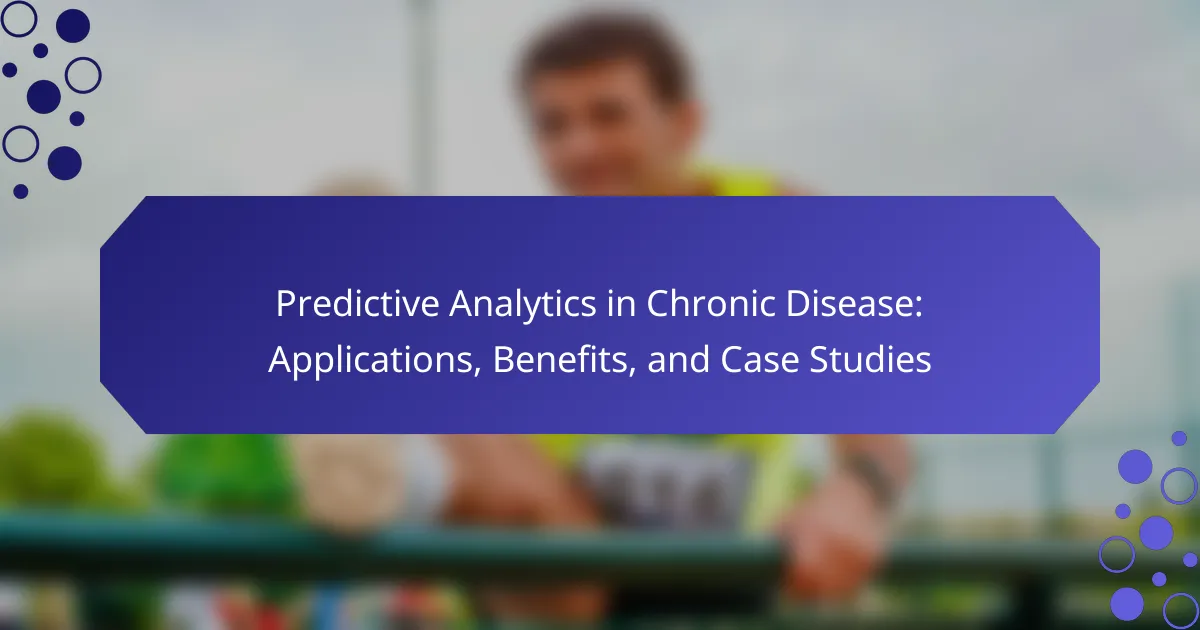Predictive analytics significantly enhances chronic disease management by identifying at-risk patients and personalizing treatment plans. This approach enables early diagnosis, optimizes resource allocation, and improves patient outcomes. Leading organizations like the Mayo Clinic and IBM Watson Health utilize predictive models to forecast disease progression and streamline care delivery. Future trends include advancements in machine learning and integration with wearable technology for more effective interventions.
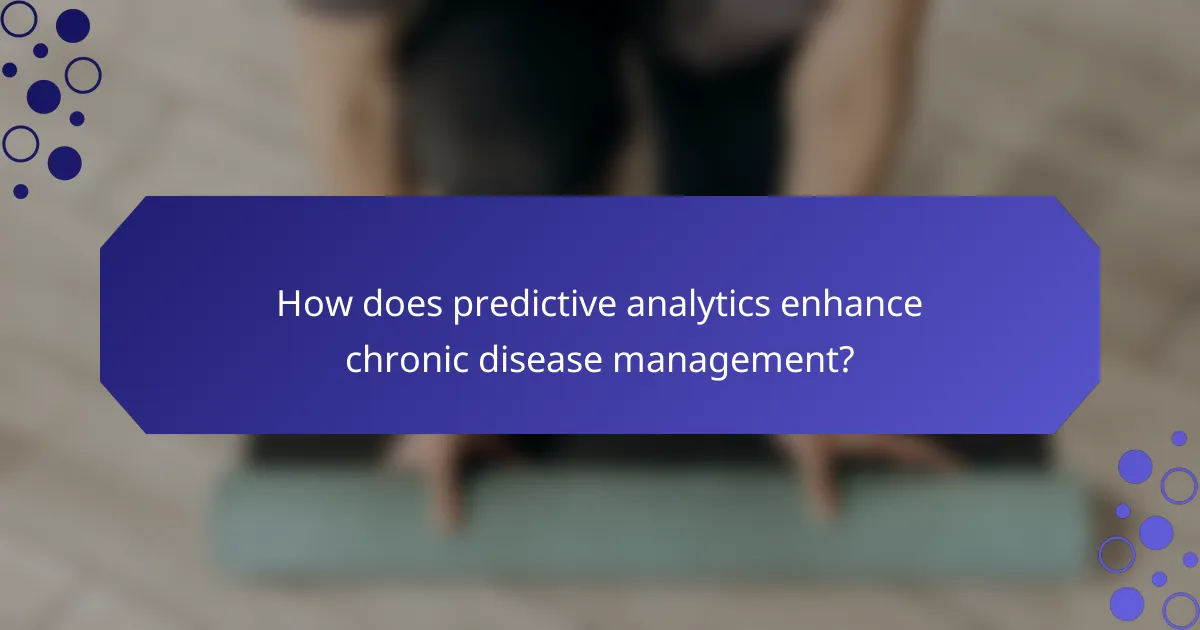
How does predictive analytics enhance chronic disease management?
Predictive analytics enhances chronic disease management by identifying at-risk patients and personalizing treatment plans. It leverages data patterns to forecast disease progression, enabling timely interventions. For instance, healthcare providers can analyze historical patient data to anticipate complications, improving patient outcomes and reducing healthcare costs. Additionally, predictive models can optimize resource allocation, ensuring that healthcare systems are prepared for patient needs.
What are the key components of predictive analytics in healthcare?
Predictive analytics in healthcare consists of data collection, statistical analysis, and machine learning techniques. These components enable healthcare providers to forecast patient outcomes, identify high-risk populations, and improve resource allocation. Advanced algorithms analyze historical data to uncover patterns and trends, facilitating proactive interventions. Integration of electronic health records enhances the accuracy of predictions, leading to better management of chronic diseases.
Which chronic diseases benefit most from predictive analytics?
Chronic diseases that benefit most from predictive analytics include diabetes, heart disease, chronic respiratory diseases, and cancer. These conditions can leverage predictive models to enhance patient outcomes, reduce hospitalizations, and optimize treatment plans. For example, predictive analytics can identify patients at high risk for complications, allowing for timely interventions. Data-driven insights enable healthcare providers to tailor strategies that improve management and prevention of these chronic diseases.
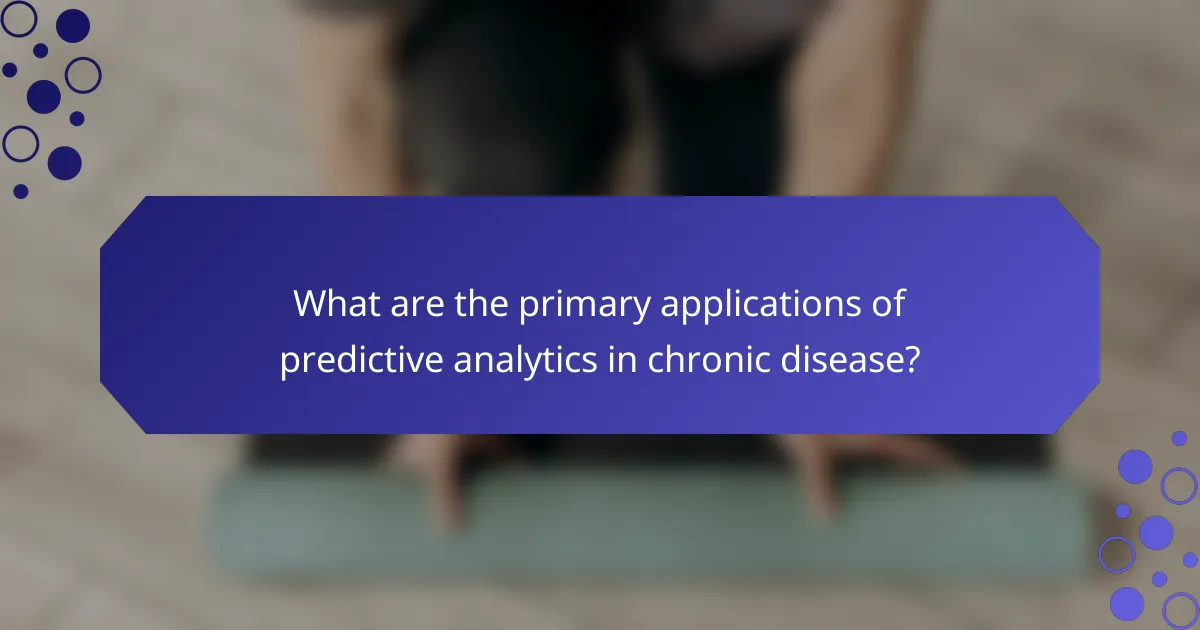
What are the primary applications of predictive analytics in chronic disease?
Predictive analytics in chronic disease primarily applies to early diagnosis, personalized treatment plans, and resource allocation. It enhances patient outcomes by identifying risk factors and forecasting disease progression. For example, analytics can predict diabetes complications, enabling timely interventions. Additionally, healthcare providers utilize these insights for efficient management of chronic diseases, optimizing care delivery and reducing costs.
How is predictive modeling used to forecast disease progression?
Predictive modeling forecasts disease progression by analyzing patient data to identify patterns and risk factors. It enables healthcare professionals to anticipate future health outcomes, tailor interventions, and improve patient management. For example, algorithms can predict the likelihood of complications in chronic diseases like diabetes or heart disease, allowing for timely preventive measures. This approach enhances treatment efficacy and patient quality of life by facilitating personalized care strategies.
What role does patient data play in predictive analytics?
Patient data is crucial for predictive analytics as it enhances the accuracy of disease forecasting. By analyzing historical health records, demographics, and treatment outcomes, healthcare providers can identify patterns and risk factors associated with chronic diseases. This data-driven approach enables earlier interventions, personalized treatment plans, and improved patient outcomes. For instance, leveraging patient data can predict hospital readmission rates, allowing for proactive care strategies. Additionally, integrating real-time data from wearable devices further refines predictions, showcasing the transformative impact of patient data in chronic disease management.
How can predictive analytics improve patient engagement and adherence?
Predictive analytics enhances patient engagement and adherence by identifying at-risk individuals and personalizing interventions. It analyzes data trends to forecast behaviors, allowing healthcare providers to tailor communication and support. For example, predictive models can determine which patients are likely to miss appointments, enabling proactive outreach. As a result, healthcare teams can foster a more supportive environment, improving overall health outcomes.
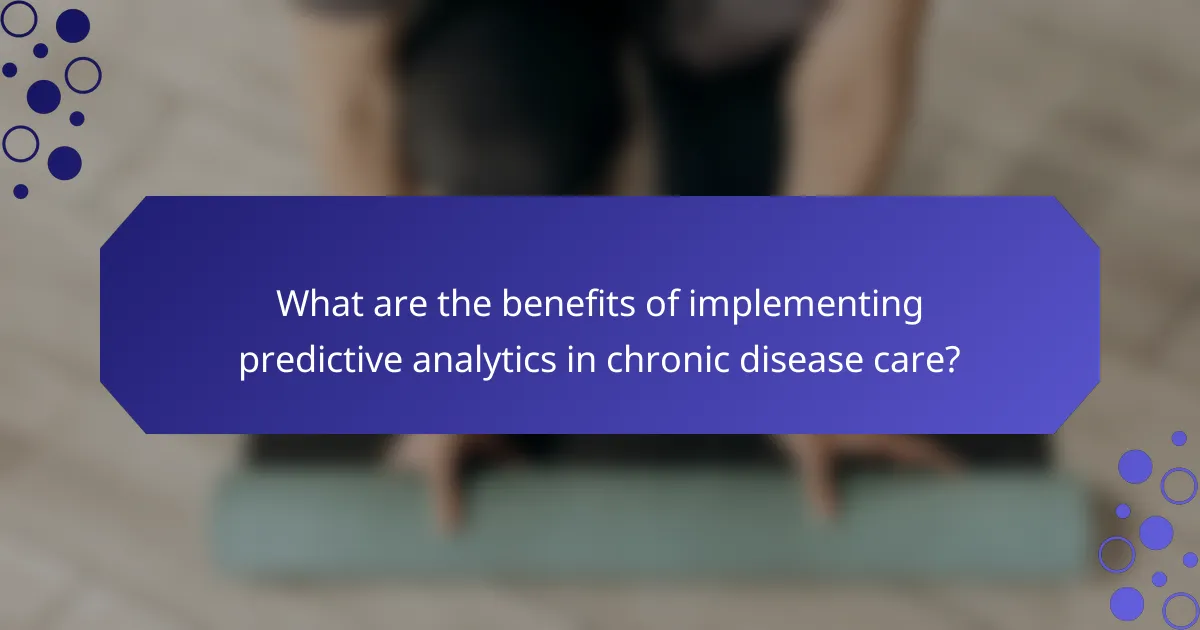
What are the benefits of implementing predictive analytics in chronic disease care?
Implementing predictive analytics in chronic disease care enhances patient outcomes, optimizes resource allocation, and reduces healthcare costs. It enables early intervention by identifying high-risk patients, thus improving management strategies. For example, predictive models can forecast disease progression, allowing for timely treatment adjustments. Additionally, these analytics facilitate personalized care plans tailored to individual patient needs, increasing adherence and satisfaction.
How does predictive analytics reduce healthcare costs?
Predictive analytics reduces healthcare costs by enabling early intervention and personalized treatment plans. By analyzing patient data, healthcare providers can identify at-risk populations, optimize resource allocation, and reduce hospital readmissions. For instance, predictive models can forecast disease progression, allowing for timely preventive measures. This proactive approach ultimately leads to significant cost savings in managing chronic diseases.
What impact does predictive analytics have on patient outcomes?
Predictive analytics significantly enhances patient outcomes by anticipating health issues and personalizing care. It enables early intervention, leading to improved management of chronic diseases. For instance, predictive models can identify patients at high risk for complications, allowing healthcare providers to tailor treatment plans effectively. Studies show that hospitals using predictive analytics reduced readmission rates by 20%, demonstrating its impact on patient care quality.
How can predictive analytics facilitate personalized treatment plans?
Predictive analytics can significantly enhance personalized treatment plans by analyzing patient data to identify optimal interventions. This approach enables healthcare providers to tailor therapies based on individual risk factors, treatment responses, and disease progression patterns. By leveraging historical data, predictive models can forecast outcomes, improving patient engagement and adherence. As a result, personalized treatment plans become more efficient, potentially leading to better health outcomes and reduced healthcare costs.
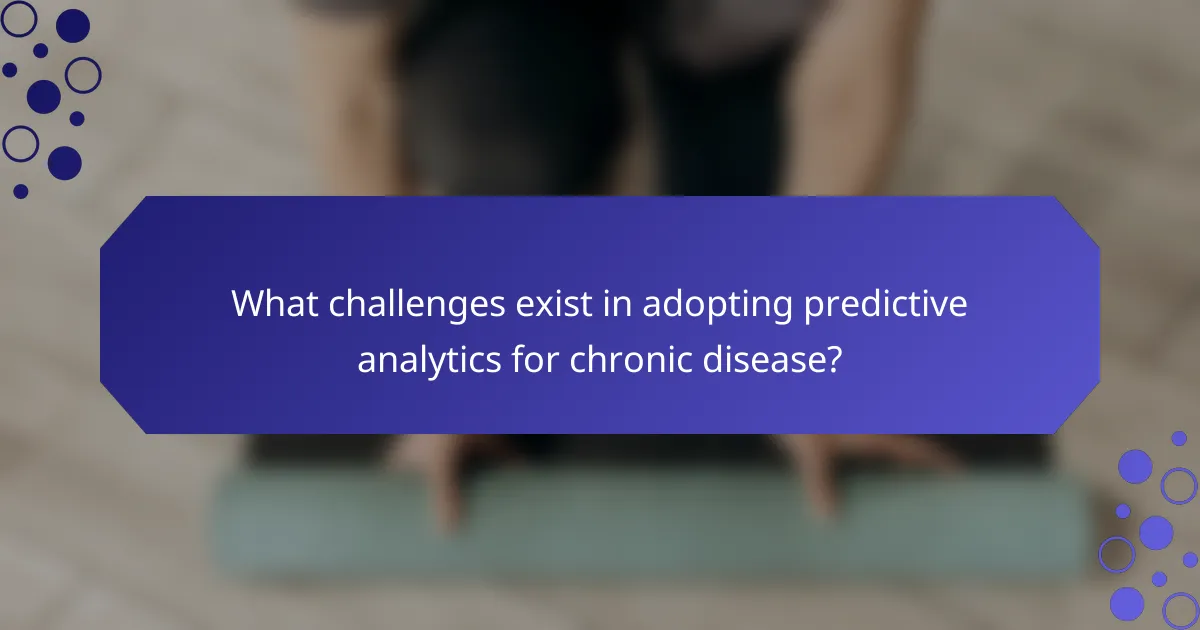
What challenges exist in adopting predictive analytics for chronic disease?
Adopting predictive analytics for chronic disease faces several challenges. Data quality issues, such as incomplete or inaccurate health records, hinder effective analysis. Privacy concerns about patient data can limit access and use. Additionally, integrating predictive models into existing healthcare workflows poses technical difficulties. There is also a lack of skilled personnel trained in data science and analytics within healthcare settings. Finally, resistance to change among healthcare professionals can impede the adoption of new technologies.
How do data privacy concerns affect predictive analytics usage?
Data privacy concerns significantly limit predictive analytics usage by restricting data access and sharing. Organizations face challenges in collecting, storing, and analyzing personal health data due to stringent regulations like GDPR and HIPAA. These regulations mandate consent and transparency, which can hinder the development of predictive models. As a result, the accuracy and effectiveness of predictive analytics in chronic disease management may be compromised. Balancing data utility with privacy is essential for advancing predictive analytics while ensuring compliance and trust.
What are the technological barriers to implementing predictive analytics?
Technological barriers to implementing predictive analytics include data integration challenges, insufficient data quality, and lack of skilled personnel. These obstacles hinder effective analysis and application in chronic disease management. Data silos prevent seamless information flow, while poor data accuracy limits predictive capabilities. Additionally, a shortage of expertise in data science and analytics complicates the development and deployment of predictive models.
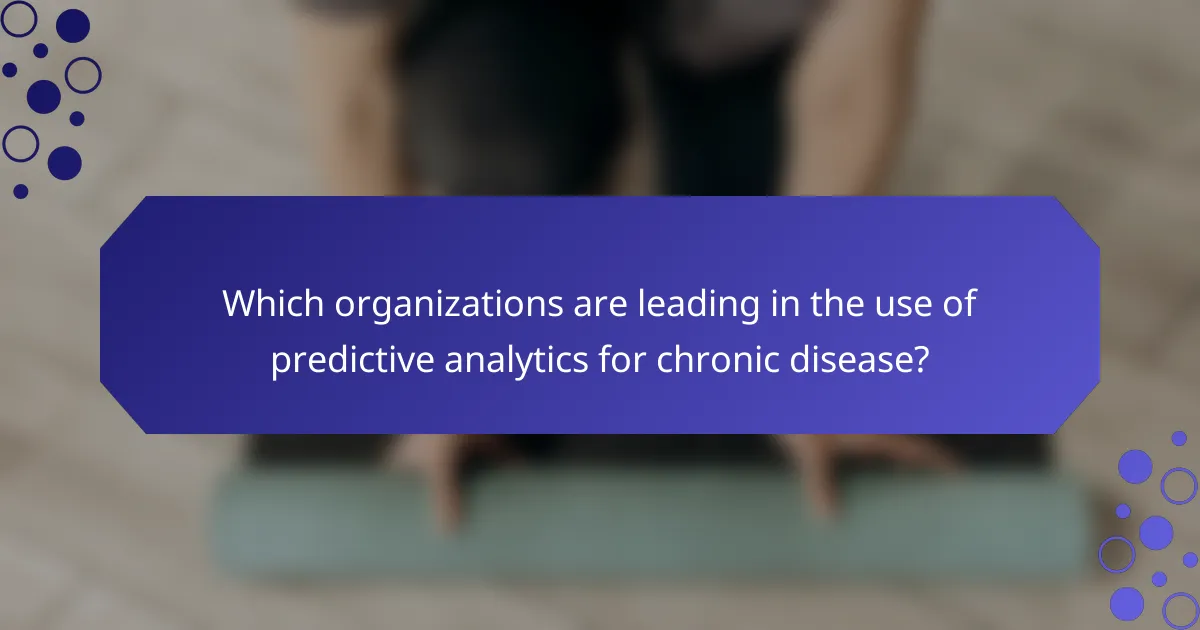
Which organizations are leading in the use of predictive analytics for chronic disease?
Leading organizations in predictive analytics for chronic disease include the Mayo Clinic, IBM Watson Health, and the World Health Organization. These entities leverage advanced data analysis to improve patient outcomes and streamline healthcare processes. For instance, the Mayo Clinic uses predictive models to identify at-risk patients, enhancing early intervention strategies. IBM Watson Health applies machine learning algorithms to analyze vast datasets, helping to predict disease trends. The World Health Organization utilizes predictive analytics for global health monitoring, allowing for timely responses to chronic disease outbreaks.
What innovative case studies showcase successful predictive analytics applications?
Successful predictive analytics applications in chronic disease include case studies from healthcare organizations leveraging data to improve patient outcomes. For instance, a notable case study from Mount Sinai Health System utilized predictive analytics to identify patients at high risk for hospital readmission. This initiative led to a 20% reduction in readmissions by implementing targeted interventions. Another example is the University of California, San Francisco, which used predictive models to forecast diabetes complications, resulting in improved management strategies and patient education. These cases illustrate the transformative impact of predictive analytics in enhancing chronic disease care.
How are healthcare providers collaborating with tech companies for predictive analytics?
Healthcare providers are increasingly collaborating with tech companies to enhance predictive analytics in chronic disease management. These partnerships leverage advanced data analytics to identify at-risk patients and improve treatment outcomes.
Healthcare providers utilize predictive analytics to analyze patient data, enabling early intervention and personalized care plans. For instance, by integrating electronic health records with machine learning algorithms, they can forecast disease progression and adjust treatment strategies accordingly.
The benefits of these collaborations include improved patient outcomes, reduced hospital readmissions, and optimized resource allocation. Case studies demonstrate significant advancements in diabetes and heart disease management, showcasing the effectiveness of predictive models in real-world settings.
As a result, the integration of technology in healthcare not only enhances patient care but also streamlines operations, making healthcare delivery more efficient and proactive.
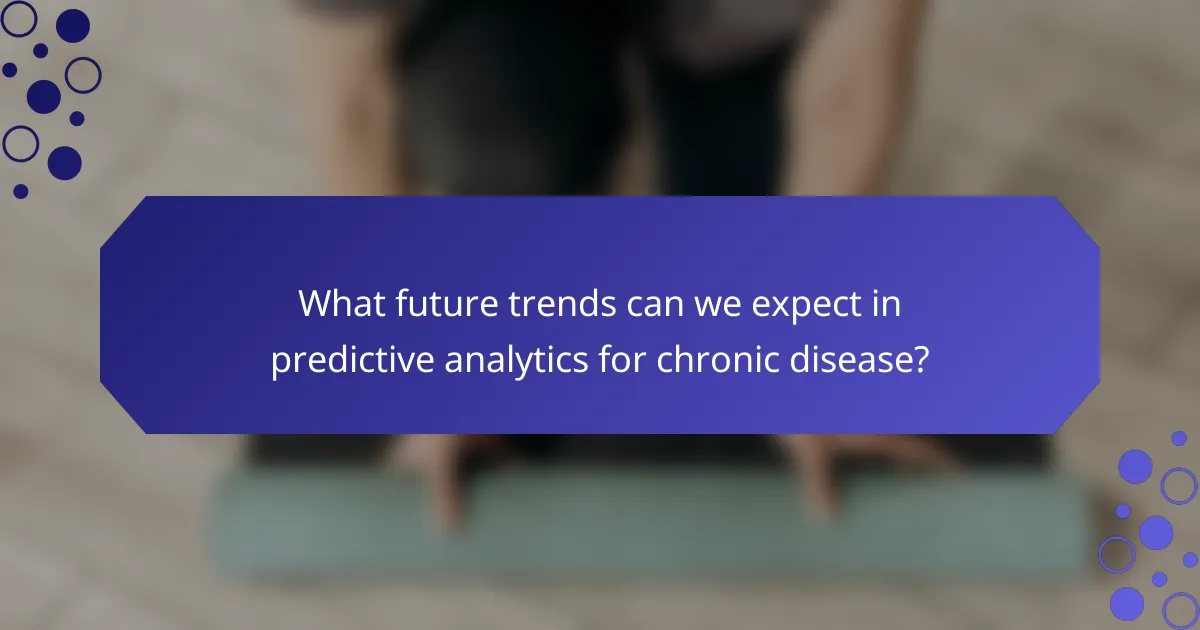
What future trends can we expect in predictive analytics for chronic disease?
Future trends in predictive analytics for chronic disease include enhanced machine learning algorithms, integration with wearable technology, and increased focus on personalized medicine. These advancements will improve early detection, treatment planning, and patient outcomes. For instance, machine learning can analyze vast datasets to identify risk factors, while wearables provide real-time health monitoring. Personalized medicine will tailor interventions based on individual genetic and lifestyle data, making treatments more effective. As a result, predictive analytics will play a crucial role in managing chronic diseases more efficiently.
How will advancements in AI influence predictive analytics?
Advancements in AI will significantly enhance predictive analytics by improving accuracy and efficiency. AI algorithms can analyze vast datasets, uncovering patterns that traditional methods may miss. This capability allows for more precise predictions in chronic disease management, leading to timely interventions and personalized treatment plans. For instance, machine learning models can predict disease progression based on patient data, optimizing healthcare resources. As a result, healthcare providers can implement proactive strategies, improving patient outcomes and reducing costs.
What are the emerging tools and technologies in predictive analytics?
Emerging tools and technologies in predictive analytics include machine learning algorithms, big data platforms, and cloud computing services. These innovations enhance data processing, improve accuracy, and facilitate real-time analysis. For instance, machine learning models can identify patterns in chronic disease data, enabling proactive healthcare interventions. Additionally, cloud solutions provide scalable resources for handling vast datasets, improving accessibility and collaboration among healthcare professionals.
What best practices should organizations follow when implementing predictive analytics?
Organizations should prioritize data quality, stakeholder engagement, and iterative processes when implementing predictive analytics. Ensuring accurate and reliable data is crucial for effective predictions. Engaging stakeholders throughout the process fosters collaboration and alignment with organizational goals. Iterative processes allow for continuous improvement and adaptation of models based on new insights and outcomes. These best practices enhance the effectiveness of predictive analytics in chronic disease management.
